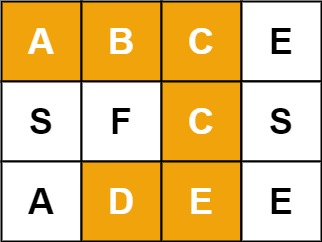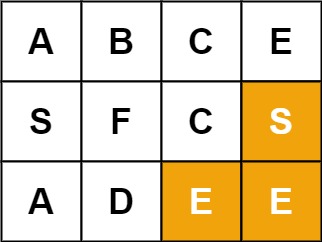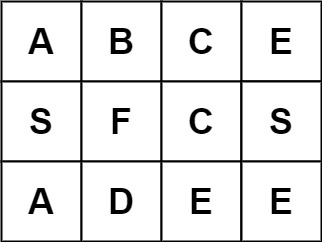Given an m x n grid of characters board and a string word, return true if word exists in the grid.
The word can be constructed from letters of sequentially adjacent cells, where adjacent cells are horizontally or vertically neighboring. The same letter cell may not be used more than once.
Example 1:

Input: board = [["A","B","C","E"],["S","F","C","S"],["A","D","E","E"]], word = "ABCCED"
Output: true
Example 2:

Input: board = [["A","B","C","E"],["S","F","C","S"],["A","D","E","E"]], word = "SEE"
Output: true
Example 3:

Input: board = [["A","B","C","E"],["S","F","C","S"],["A","D","E","E"]], word = "ABCB"
Output: false
Constraints:
m == board.length
n = board[i].length
1 <= m, n <= 6
1 <= word.length <= 15
board and word consists of only lowercase and uppercase English letters.題目給了一個字元矩陣 board 與一個字串 word
要求實作一個演算法去判斷這個 word 是否有存在這個矩陣,注意的是每個字元組成字串的形式是水平或垂直鄰近的字元做連接並且只能使用一次。
矩陣為 m by n ,連結的方向有水平跟垂直
所以對於從每個矩陣的字元為開始,總共有 4 種接續的可能
因為最遭的狀況是 $(4^m)^n$
以有找到的狀況一般case 假設找到 k 字元 ,且字元長度是 p
則總搜尋時間是 k + $4^p$
k 介於 1 ~ m*n - 1
相鄰的查找方式需要使用 DFS 來做實作
如下圖

package sol
type Pair struct {
row, col int
}
func exist(board [][]byte, word string) bool {
row := len(board)
col := len(board[0])
visit := make(map[Pair]struct{})
var dfs func(r, c, idx int) bool
dfs = func(r, c, idx int) bool {
if idx == len(word) { // match all prefix
return true
}
if r < 0 || r >= row || c < 0 || c >= col {
return false
}
// revisited
if _, visited := visit[Pair{row: r, col: c}]; visited {
return false
}
// not match
if board[r][c] != word[idx] {
return false
}
// marked visited
visit[Pair{row: r, col: c}] = struct{}{}
if dfs(r-1, c, idx+1) || dfs(r+1, c, idx+1) || dfs(r, c-1, idx+1) || dfs(r, c+1, idx+1) {
return true
}
// delete marked
delete(visit, Pair{row: r, col: c})
return false
}
for r := 0; r < row; r++ {
for c := 0; c < col; c++ {
if dfs(r, c, 0) {
return true
}
}
}
return false
}
